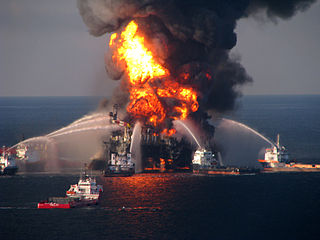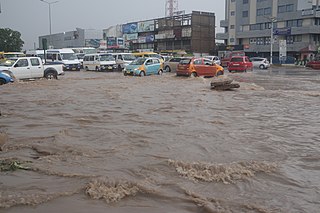
Freetown is the capital and largest city of Sierra Leone. It is a major port city on the Atlantic Ocean and is located in the Western Area of the country. Freetown is Sierra Leone's major urban, economic, financial, cultural, educational and political centre, as it is the seat of the Government of Sierra Leone. The population of Freetown was 1,055,964 at the 2015 census.
The Yaoundé train explosion was the catastrophic fire following the derailment and collision of two tanker trains hauling crude oil through the capital of Cameroon, Yaoundé. At least 200 people were killed in the accident, which happened on February 14, 1998.

Wellington is a residential neighborhood in the East End of Freetown, Sierra Leone. Wellington is densely populated, with an ethnically diverse population.

Energy resources bring with them great social and economic promise, providing financial growth for communities and energy services for local economies. However, the infrastructure which delivers energy services can break down in an energy accident, sometimes causing considerable damage. Energy fatalities can occur, and with many systems deaths will happen often, even when the systems are working as intended.
The 2011 Nairobi pipeline fire was caused by an explosion secondary to a fuel spill in the Kenyan capital Nairobi on 12 September 2011. Approximately 100 people were killed in the fire and at least 116 others were hospitalized with varying degrees of burns. The incident was not the first such pipeline accident in Kenya, with the Molo fire of 2009 resulting in at least 133 fatalities and hundreds more injured.
MV Dromus was a 1930s British oil tanker owned by Anglo-Saxon Petroleum, a British subsidiary of Royal Dutch Shell. She was launched in September 1938 by Harland and Wolff at Belfast in Northern Ireland. She was one of a class of 20 similar tankers built for Anglo-Saxon.

An Ebola virus epidemic in Sierra Leone occurred in 2014, along with the neighbouring countries of Guinea and Liberia. At the time it was discovered, it was thought that Ebola virus was not endemic to Sierra Leone or to the West African region and that the epidemic represented the first time the virus was discovered there. However, US researchers pointed to lab samples used for Lassa fever testing to suggest that Ebola had been in Sierra Leone as early as 2006.
On June 3, 2015, an explosion and a fire occurred at a petrol station in Ghana's capital city Accra, killing over 250 people.

The 2015 Accra floods resulted from heavy continuous rainfall in Accra, the largest city in Ghana. The rain started on 1 June 2015. Other causes of this flood is as a result of the improper planning of settlement in Accra, choked gutters which block the drainage system and a few other human factors. The floods have resulted in heavy traffic on the roads in the city and also a halt in commercial activities as markets were flooded and workers trapped. Mayor of Accra Metropolitan Assembly, Alfred Oko Vanderpuije described the flooding as critical. At least 25 people have died from the flooding directly, while a petrol station explosion caused by the flooding killed at least 200 more people.

On the morning of August 14, 2017, significant mudflow events occurred in and around the capital city of Freetown in Sierra Leone. Following three days of torrential rainfall, mass wasting of mud and debris damaged or destroyed hundreds of buildings in the city, killing 1,141 people and leaving more than 3,000 homeless.
On 7 October 2017, an offloading petrol tanker located at the state-owned Ghana Oil Company (GOIL) caught fire resulting in a large-scale explosion at the site of a liquefied natural gas station located at Atomic Junction in Madina, Accra, Ghana. The explosion was not isolated to the tanker at the station, with the fire promptly radiating towards a cooking gas depot situated next door. The Ministry of Information released a formal statement that confirmed 7 people had been killed and 132 people were injured during the blast.. Residents of the busy intersection in northeast Accra were forced to flee as the blasts were followed by a giant fireball erupting into the sky over eastern Accra. The Interior Minister, Hon. Ambrose Dery MP, attended the scene alongside other government officials and emergency service personnel from the Atomic Fire Brigade, Ghana National Fire Service, Ghana Police Service, and the National Disaster Management Organisation to monitor the situation. In the aftermath of the explosion, a constituency official delivered a statement to the Parliament of Ghana in which they addressed the threats posed to the public because of recurrent gas explosions in the region, including the threat to human lives, subsequent damage to properties and businesses, declines in available resources and nationwide job shortages. As a result of the quantity of both lives and properties lost, a statement was read in parliament encouraging the consideration of the relocation of such liquefied natural gas stations to the outside of residential regions and spaces accessible by the public. On 8 October 2017, Mahamudu Bawumia, the Vice President of Ghana, addressed the public during a press conference vowing a national response in the aftermath of the explosion to put new policies and procedures into action to minimise the risk of similar incidents occurring in the future.
Events in the year 2021 in Sierra Leone.

On 14 December 2021, a fuel tank truck exploded in the Samari neighborhood of Cap-Haïtien, the capital city of the Haitian department of Nord. At least 90 people were killed and more than 120 were injured; many people were injured as a result of rushing towards the tanker, likely to collect some of its cargo, before the explosion occurred. Many inhabitants were suffering from financial crisis.
In August 2022, violent protests and riots broke out in Sierra Leone. The protests were concentrated in the capital, Freetown, and in the north, including Makeni and Kamakwie. The protests were triggered by the nation's cost of living crisis. A nationwide curfew was implemented. At least twenty-seven civilians and six police officers died in the protests.
The Boksburg explosion took place on 24 December 2022, when a fuel tanker carrying liquefied petroleum gas (LPG) exploded underneath a railway bridge in Boksburg, in the Ekurhuleni Metropolitan Municipality in Gauteng, South Africa, with a death toll of 41 people as of 18 January 2023. Nearby infrastructure was damaged by the explosion.
The 2004 Nosratabad fuel tanker explosion was a catastrophic incident that took place on 24 June 2004, near Iran's border with Afghanistan, resulting in at least 90 fatalities and 114 injuries. The disaster occurred when a petrol truck lost control and collided with a bus at the Nosratabad police checkpoint, located about 110 kilometres (68 mi) west of Zahedan.
On 18 December 2023, an explosion and fire broke out at an oil depot in Conakry, Guinea, killing at least 24 people and injuring 454 and resulting in fuel shortages across the country.







